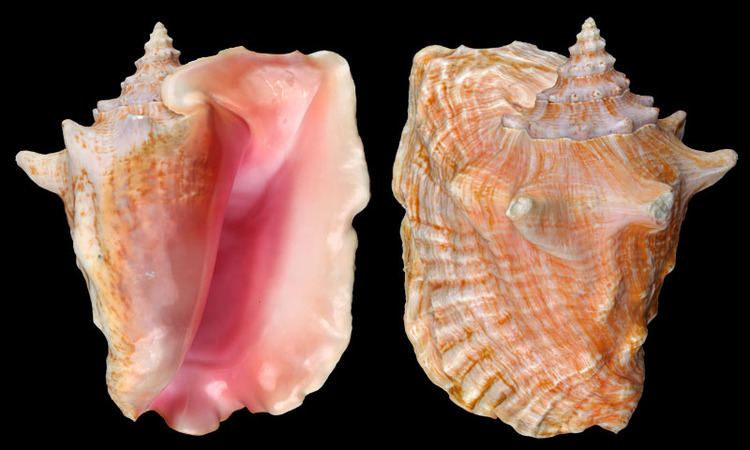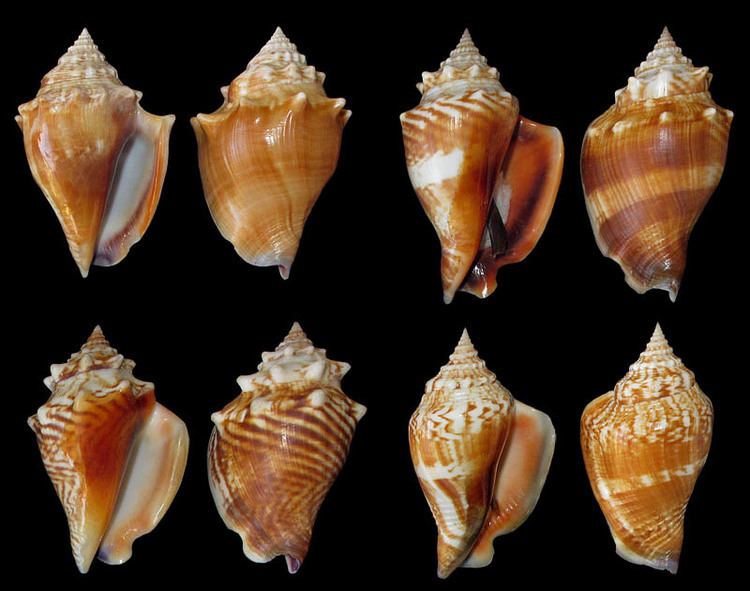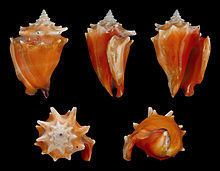Scientific name Strombus Rank Genus | ||
 | ||
Lower classifications Lobatus gigas, Strombus pugilis, Strombus alatus, Roostertail conch, Hawkwing Conch | ||
Strombus
Strombus is a genus of medium to large sea snails, marine gastropod molluscs in the family Strombidae, which comprises the true conchs and their immediate relatives. The genus Strombus was named by Swedish Naturalist Carl Linnaeus in 1758. There were around 50 living species recognized, which vary in size from fairly small to very large. Six species live in the greater Caribbean region, including the queen conch, Strombus gigas (now usually known as Eustrombus gigas or Lobatus gigas), and the West Indian fighting conch, Strombus pugilis. However, since 2006, many species have been assigned to discrete genera. These new genera are however not yet found in most textbooks and collector's guides.
Contents

Worldwide, several of the larger species are economically important as food sources; these include the endangered queen conch which very rarely also produces a pink, gem quality pearl.

In the geological past, a much larger number of species of Strombus existed. Fossils of species within this genus have been found all over the world in sediments from Cretaceous to Quaternary (age range: 140.2 to 0.0 million years ago).

Of the living species, most are in the Indian and Pacific Oceans. Many species of true conchs live on sandy bottoms among beds of sea grass in tropical waters. They eat algae and have a claw-shaped operculum.

Spiney conch strombus bulla
Anatomy

Like almost all shelled gastropods, conches have spirally constructed shells. Again, as is normally the case in many gastropods, this spiral shell growth is usually right-handed, but on very rare occasions it can be left-handed.

True conches have long eye stalks, with colorful ring-marked eyes at the tips. The shell has a long and narrow aperture, and a short siphonal canal, with another indentation near the anterior end called a stromboid notch. This notch is where one of the two eye stalks protrudes from the shell.
The true conch has a foot ending in a pointed, sickle-shaped, operculum which can be dug into the substrate as part of an unusual "leaping" locomotion.
True conches grow a flared lip on their shells only upon reaching sexual maturity. This is called an alated outer lip or alation.
Conches lay eggs in long strands: the eggs are contained in twisted gelatinous tubes. Strombus moves with a leaping motion.
Shell description
Strombus shells have a flaring outer lip with a notch near the anterior end called the stromboid notch through which the animal can protrude one of its stalked eyes.
Phylogeny
The phylogenetic relationships among the Strombidae have been mainly accessed in two different occasions, using two distinct methods. In a 2005 monograph, Simone proposed a cladogram (a tree of descent) based on an extensive morpho-anatomical analysis of representatives of Aporrhaidae, Strombidae, Xenophoridae and Struthiolariidae. However, according to Simone, only Strombus gracilior, Strombus alatus and Strombus pugilis, the type species, remained within Strombus. In Simone's cladogram, these three species constituted a distinct group based on at least five synapomorphies (traits that are shared by two or more taxa and their most recent common ancestor). The remaining taxa were previously considered as subgenera, and were elevated to genus level by Simone in the end of his analysis.
In a different approach, Latiolais and colleagues (2006) proposed another cladogram that attempts to show the phylogenetic relationships of 34 species within the family Strombidae. The authors analysed 31 species in the genus Strombus and three species in the allied genus Lambis. The cladogram was based on DNA sequences of both nuclear histone H3 and mitochondrial cytochrome-c oxidase I (COI) protein-coding gene regions. In this proposed phylogeny, Strombus pugilis, Strombus alatus, Strombus granulatus and Strombus gracilior are closely related and appear to share a common ancestor.
Species
This genus of sea snails used to comprise about 50 species, 38 of them occurring in the Indo-Pacific region. Species within the genus Strombus include:
Extinct species within this genus include:
